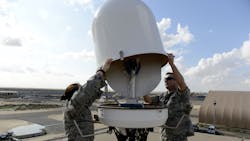Air Force chooses EWR Radar Systems to provide Portable Doppler Radar (PDR) systems for weather forecasting
HANSCOM AIR FORCE BASE, Mass. – U.S. Air Force weather experts needed portable Doppler radar systems for relocatable weather forecasting applications. They found their solution from EWR Radar Systems Inc. in St. Louis.
Officials of the Digital Directorate of the Air Force Aerospace Management Systems Division at Hanscom Air Force Base, Mass., announced a $20.7 million sole-source contract to EWR on Friday for the Portable Doppler Radar (PDR) program. EWR will provide 22 PDR systems with an option to buy as many as 14 additional portable Doppler radar systems.
Doppler weather radar locates precipitation, calculates its motion and intensity, and estimate its type, such as rain, snow, or hail. It can help weather forecasters determine the structure of storms and their potential to cause severe weather.
EWR provides the E700XD portable Doppler radar, which combines solid state technology, digital signal processing into a compact, portable and advanced Doppler weather radar.
Related: Doppler-based weather radars for general aviation aircraft avionics introduced by Garmin
Designed for mounting on a retractable mast, tower, rooftop, trailer, or vehicle, the E700XD is composed of three main components: the radar pedestal unit; radar server and power supply; and commercial off-the-shelf (COTS) PC workstation.
The radar pedestal unit contains the radar's receiver, transmitter, antenna, and signal processor. The radar server and power supply is housed in an environmentally controlled ruggedized case for field deployment. The COTS PC workstation works on a PC or laptop computer that runs the EWR WeatherScout radar control and display software.
The E700XD’s pulse compression transmitter transmits long pulses at relatively low power levels to provide the equivalent sensitivity as a short pulse at high power, while compressing the pulse in the signal processor to provide the same short range resolution obtained by transmitting a short pulse.
Related: National Weather service eyes backplane and circuit card upgrades to NEXRAD weather radar
The system can provide equivalent or better sensitivity and range resolution compared to a 10-12-kilowatt radar while transmitting a fraction of that power, company officials say.
EWR is a supplier of ground based weather radar systems for the U.S. Air Force Special Operations Command, the U.S. Marine Corps Meteorological Mobile Facility (METMF) Next Generation (NEXGEN) systems, and for the Air Force PDR program.
On this contract EWR will do the work in St. Louis, and should be finished by January 2023. For more information contact EWR Radar Systems https://ewradar.com, or the Air Force Life Cycle Management Center at www.aflcmc.af.mil.
About the Author
John Keller
Editor-in-Chief
John Keller is the Editor-in-Chief, Military & Aerospace Electronics Magazine--provides extensive coverage and analysis of enabling electronics and optoelectronic technologies in military, space and commercial aviation applications. John has been a member of the Military & Aerospace Electronics staff since 1989 and chief editor since 1995.
